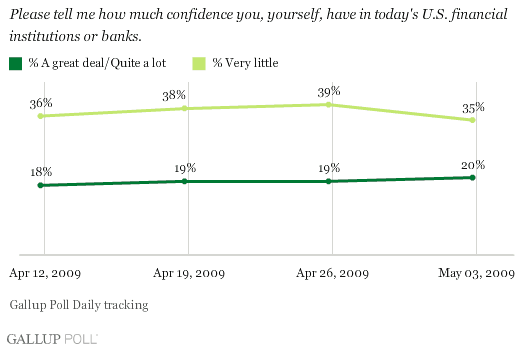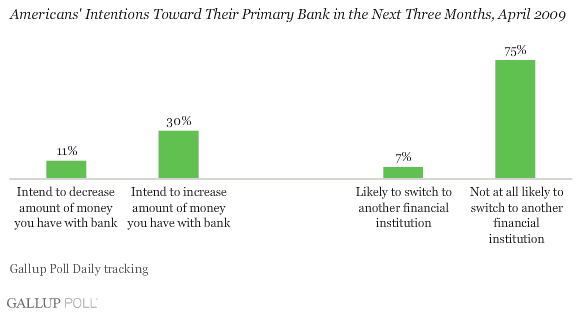PRINCETON, NJ -- As Thursday's official release of the so-called bank "stress tests" approaches, Americans' confidence in U.S. banks remains at low levels. Between 18% and 20% of Americans have expressed "a great deal" or "quite a lot" of confidence over the past four weeks, while between 35% and 39% have said they have "very little" confidence.

Confidence in U.S. Banking
Gallup began asking Americans about their confidence in banking in April 1979. Prior to this year, the combined "great deal" and "quite a lot of confidence" numbers had not fallen below the 30% of the 1990-91 recession -- a percentage that also reflected the fallout of the S&L debacle of the late 1980s. Thus, the early April 2009 reading of 18% who have a great deal/quite a lot of confidence in U.S. banks represents a new low.
Even as confidence in U.S. banks in general has plunged, many Americans continue to express confidence in the main or primary bank where they do most of their banking business. Over the last four weeks, 60% have said they have a great deal (27%) or quite a lot (33%) of confidence in their main bank. Only 12% have expressed very little confidence in that bank. This higher level of confidence in one's primary bank is consistent with Gallup Poll findings more generally showing that Americans typically rate their own local providers and institutions much better than those in the broader United States.

Consumer Intentions
Given the current consumer tendency to try to save more and the much higher degree of confidence Americans have in their primary bank than in banks generally, it should not be surprising that 30% say they plan to increase the money they have deposited with their main bank over the next three months. At the same time, 11% say they intend to decrease their balances. Further, while 75% say they are "not at all likely" to switch their main bank in the next three months, 7% do say they are likely to do so.

Commentary
The Federal Reserve Board, the U.S. Treasury, and banking regulators have a major challenge in the behavioral economics art of "framing" as they release the results of the so-called banking "stress tests." While the real financial condition of U.S. banks is whatever it is, the way the "stress test" results are presented could significantly affect overall perceptions of U.S. banks, on the part of both Americans and global investors. And this task of "framing" is already being made more difficult by the numerous leaks taking place prior to the official release of the numbers after the markets close on Thursday.
In one sense, most Americans who do not hold bank stocks are pretty well insulated from the direct fallout of these viability assessments. Federal deposit insurance, the Treasury, and the Fed have all created a strong safety net for the average bank depositor. However, the bank stress tests will have significant real-world effects. For one thing, if the results are interpreted as signaling the end of the financial crisis that began last September, they could add to the general perception that the overall economy is over the worst of the recession and is stabilizing. On the other hand, if the results suggest the need for many banks to get new capital that banks can't produce -- and therefore require more direct federal government involvement in the nation's major banking institutions, the stress tests could do just the reverse.
In reality, the federal government stands behind the U.S. financial system and does so because the banking system is a "public good" -- something the economy needs in order to function properly for the good of all Americans. Ideally, this government backing is exhibited indirectly through such things as federal deposit insurance, and banking regulation and supervision. When the federal government decided to purchase preferred stock in the nation's major banks, it made its backing of the banking system even more explicit, but stopped somewhat short of exerting full ownership rights. The real question as the government stress-test results are presented is not whether the nation's banks are safe and sound -- they are, because the federal government and all its financial resources stand behind them -- but instead, whether the government is going to exert more ownership by forcing various major U.S. banks to convert the government's preferred stock to common stock.
Success in "framing" the results of the banking stress tests will be determined by whether Americans' confidence in U.S. banks increases in the weeks and months ahead -- and Gallup will continue to monitor that success or the lack of it. Success in maintaining limits on the degree to which the federal government inserts itself into U.S. banking -- thus preserving a key aspect of free-market capitalism -- will be determined by how this goal of increasing Americans' confidence in banking is actually achieved.
Survey Methods
Results are based on telephone interviews with 805 national adults, aged 18 and older, conducted April 6-12; 924 adults, conducted April 13-19; 3,995 adults, conducted April 20-26; and 975 adults, conducted April 27-May 3, 2009, as part of the Gallup Poll Daily tracking. For results based on these samples, one can say with 95% confidence that the maximum margin of sampling error is between ±2 and ±4 percentage points.
Interviews are conducted with respondents on land-line telephones (for respondents with a land-line telephone) and cellular phones (for respondents who are cell-phone only).
In addition to sampling error, question wording and practical difficulties in conducting surveys can introduce error or bias into the findings of public opinion polls.
